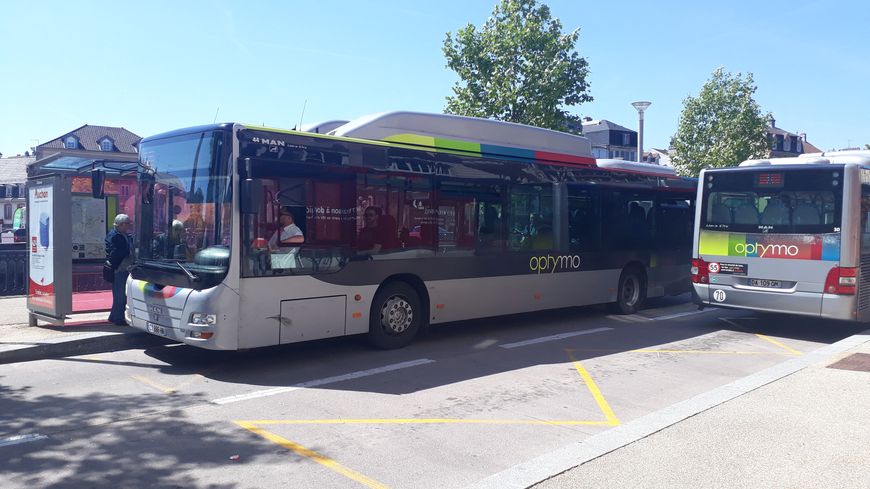The Future Of European Transit: Hydrogen Buses Vs. Battery Buses

Table of Contents
Hydrogen Buses: A Deep Dive into the Technology
Hydrogen buses represent a compelling alternative to traditional diesel and gasoline-powered vehicles, offering a pathway towards truly zero-emission public transport. They utilize hydrogen fuel cells to generate electricity, which then powers the bus's motor. This process produces only water vapor as a byproduct.
Advantages of Hydrogen Buses:
- Zero Tailpipe Emissions: Hydrogen buses contribute significantly to improved air quality in urban areas by emitting only water vapor, unlike battery buses which rely on electricity generation that may still produce emissions depending on the source. This is a crucial factor for achieving cleaner city air and improving public health.
- Rapid Refueling: Refueling a hydrogen bus takes only a few minutes, significantly faster than charging a battery bus. This minimizes downtime and allows for greater operational efficiency, especially for high-frequency routes.
- Extended Range: Hydrogen buses offer a longer range than current battery electric buses, making them suitable for longer routes and less dense urban networks. This is particularly important for connecting suburban areas and regional hubs.
- Hydrogen Fuel Cell Technology: Advancements in fuel cell technology are constantly improving efficiency and reducing costs, making hydrogen buses a more attractive proposition.
- Hydrogen Production and Storage: Progress is being made in developing sustainable methods of hydrogen production, such as electrolysis powered by renewable energy sources, and in improving the safety and efficiency of hydrogen storage tanks.
Disadvantages of Hydrogen Buses:
- High Infrastructure Costs: The initial investment required for establishing a hydrogen production and refueling infrastructure is substantial. This includes building dedicated refueling stations and potentially investing in green hydrogen production facilities.
- "Grey Hydrogen" Concerns: A significant concern is the environmental impact of hydrogen production, particularly "grey hydrogen," which is produced from natural gas and releases greenhouse gases. The transition to green hydrogen production is crucial for minimizing this impact.
- Limited Refueling Network: Currently, the availability of hydrogen refueling stations across Europe is limited, hindering the widespread adoption of hydrogen buses.
- High Vehicle Cost: Hydrogen buses are currently more expensive to purchase than battery electric buses.
- Safety Concerns: Safety protocols for handling and storing hydrogen are crucial, and addressing public concerns related to hydrogen's flammability is essential for wider acceptance.
Battery Buses: The Current Market Leader
Battery electric buses currently dominate the zero-emission bus market in Europe. They utilize rechargeable battery packs to power the electric motor, offering a relatively mature and well-established technology.
Advantages of Battery Buses:
- Lower Initial Cost: Battery buses are generally cheaper to purchase than hydrogen buses, making them more accessible for municipalities with tighter budgets.
- Established Charging Infrastructure: A relatively well-developed charging infrastructure exists in many European cities, simplifying the implementation of battery bus fleets.
- Improving Battery Technology: Battery technology continues to improve, resulting in increased range, longer lifespans, and faster charging times.
- Decreasing Battery Prices: The cost of batteries is steadily decreasing, leading to lower operational costs over the lifespan of the bus.
- Advanced Battery Management Systems: Improved battery management systems optimize battery performance, extending lifespan and improving energy efficiency.
Disadvantages of Battery Buses:
- Longer Charging Times: Charging a battery bus takes significantly longer than refueling a hydrogen bus, potentially impacting operational efficiency.
- Shorter Range: Compared to hydrogen buses, battery buses have a shorter range, limiting their applicability to certain routes, particularly those outside densely populated urban areas.
- Environmental Concerns of Battery Production and Disposal: The environmental impact of battery production and the ethical implications of rare earth mineral sourcing and battery disposal need to be addressed.
- Battery Lifespan and Cost: The lifespan of batteries impacts long-term operational costs. Replacing batteries can be expensive and adds to the overall lifecycle cost.
- Grid Capacity Challenges: Widespread adoption of battery buses could strain existing electricity grids, particularly during peak charging times.
The Comparative Analysis: Hydrogen vs. Battery – A Cost-Benefit Assessment
A comprehensive cost-benefit analysis is crucial for comparing hydrogen and battery buses. This requires considering several factors:
- Lifecycle Costs: This includes production costs, operational costs (energy consumption, maintenance), and end-of-life disposal costs. Currently, the lifecycle cost of battery buses is generally lower, but this is subject to change with technological advancements and decreasing hydrogen production costs.
- Environmental Impact: A holistic environmental assessment must consider the entire supply chain, from material extraction and manufacturing to operation and disposal. While hydrogen buses offer zero tailpipe emissions, the production of green hydrogen needs significant improvement in terms of its environmental impact. Similarly, the environmental concerns surrounding battery production and disposal must be considered.
- Government Incentives: Government subsidies and policies play a significant role in shaping the adoption of both technologies. Financial incentives can make either technology more economically viable.
- Suitability for Different Environments: Hydrogen buses may be better suited for longer routes and less dense urban areas, while battery buses are currently more suitable for dense urban environments with established charging infrastructure.
(Insert a comparative chart or graph here visually representing the lifecycle costs, environmental impact, and suitability of hydrogen and battery buses for different scenarios.)
The Future Landscape: Policy, Investment, and Technological Advancements
The future of European transit hinges on several key factors:
- EU Policies: The European Union's policies promoting sustainable transport will significantly influence the uptake of both technologies. Funding for research and development, as well as incentives for adopting zero-emission buses, will play a crucial role.
- Investment Trends: Investment in both hydrogen and battery technologies is crucial for driving down costs and accelerating innovation. Public and private investment is needed to establish the necessary infrastructure and stimulate competition.
- Emerging Technologies: Further advancements in battery technology (solid-state batteries, improved energy density), hydrogen production (renewable energy-powered electrolysis), and fuel cell technology will shape the future competitiveness of both approaches.
- Hybrid Solutions: Hybrid solutions, such as trolleybuses with battery backup, could provide a more flexible and cost-effective approach in certain situations.
- Public-Private Partnerships: Collaboration between public authorities and private companies is crucial for successful implementation and widespread adoption.
Conclusion: Choosing the Right Path for European Transit
Both hydrogen and battery buses offer pathways towards a greener future for European public transport. Battery buses currently hold a market advantage due to lower costs and established infrastructure. However, hydrogen buses offer the potential for longer range and faster refueling, making them attractive for certain applications. A balanced approach, considering both environmental and economic factors, is crucial. The future likely involves a mix of both technologies, tailored to specific urban environments and route requirements. Further research, investment, and supportive policies are vital to accelerate the transition towards zero-emission hydrogen buses and battery buses, ensuring the sustainable future of European public transport. We urge you to stay informed, participate in discussions, and advocate for policies that support the adoption of these essential technologies in your region. The future of sustainable transportation depends on it.

Featured Posts
-
 Rihanna Debuts Giant Engagement Ring Paired With Chic Cherry Red Heels
May 07, 2025
Rihanna Debuts Giant Engagement Ring Paired With Chic Cherry Red Heels
May 07, 2025 -
 Lotto Results Wednesday 16 April 2025 Winning Numbers Revealed
May 07, 2025
Lotto Results Wednesday 16 April 2025 Winning Numbers Revealed
May 07, 2025 -
 Simone Biles In A Black Bikini A Bahamas Girls Trip
May 07, 2025
Simone Biles In A Black Bikini A Bahamas Girls Trip
May 07, 2025 -
 Happy Birthday Jackie Chan Disha Patanis Heartfelt Kung Fu Yoga Message
May 07, 2025
Happy Birthday Jackie Chan Disha Patanis Heartfelt Kung Fu Yoga Message
May 07, 2025 -
 Can You Name All The Nba Most Improved Player Award Winners A Challenging Quiz
May 07, 2025
Can You Name All The Nba Most Improved Player Award Winners A Challenging Quiz
May 07, 2025
Latest Posts
-
 The Stock Markets Struggle With Liberation Day Tariffs Challenges And Opportunities
May 08, 2025
The Stock Markets Struggle With Liberation Day Tariffs Challenges And Opportunities
May 08, 2025 -
 Identifying Emerging Business Centers A Comprehensive Map
May 08, 2025
Identifying Emerging Business Centers A Comprehensive Map
May 08, 2025 -
 New Business Hot Spots A Nationwide Map And Analysis
May 08, 2025
New Business Hot Spots A Nationwide Map And Analysis
May 08, 2025 -
 Analyzing The Long Term Effects Of Liberation Day Tariffs On Stock Investments
May 08, 2025
Analyzing The Long Term Effects Of Liberation Day Tariffs On Stock Investments
May 08, 2025 -
 The Bank Of England And The Half Point Cut A Necessary Preemptive Strike
May 08, 2025
The Bank Of England And The Half Point Cut A Necessary Preemptive Strike
May 08, 2025
